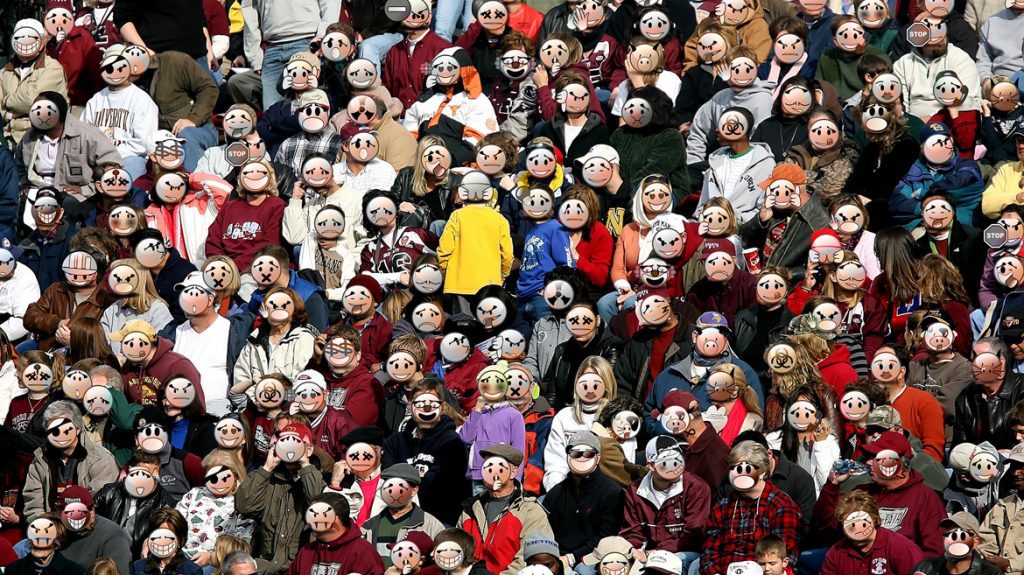
What is Visual Storytelling?
What is Visual Storytelling? https://www.visualstorytell.com/wp-content/uploads/2016/09/Header-1024x575.jpg 1024 575 Shlomi Ron Shlomi Ron https://secure.gravatar.com/avatar/995c0cf093380b90c7704fda398c9addf4e5c605afbc92af5c3f01f67d65aa41?s=96&d=mm&r=g
I am talking to a lot of folks these days about visual storytelling, and from these interactions, I learn that there is still a great deal of ambiguity about what is visual storytelling and why it’s important now for marketers. If you’re clueless too, don’t feel bad, some of the top dictionaries like Merriam-Webster and Oxford have no clue either:
Merriam-Webster:
Words fail us
Sorry, the word you’re looking for can’t be found in the dictionary.
Oxford:
No exact match found for “”visual storytelling”” in US English
When I figured, hey maybe these are old fashioned resources, let’s try Wikipedia, I received:
Visual narrative
A visual narrative (also visual storytelling) is a story told primarily through the use of visual media. The story may be told using still photography, illustration, or video, and can be enhanced with graphics, music, voice, and other audio.
Getting warmer! The reality is that the term “Visual Storytelling” is pretty new. Looking at Google Trends, for the past 12 years the term garnered low counts of under 100 searches a month, and it’s only in the past 3 years that the term is experiencing a growth, albeit still modest.

Looking closer at these searches, we find that the term “Visual Storytelling” is largely associated with topics covering the visual arts targeting artists/designers: photography, media, illustration, and infographics.

Even though the traditional meaning of visual storytelling has been with us since the first man figured hey, I could create a stencil by blowing paint on my hand held to the wall to express how my day went. Sweet!
 Sulawesi Cave in Indonesia is the world’s first cave paintings 35,000 years ago.
Sulawesi Cave in Indonesia is the world’s first cave paintings 35,000 years ago.
BTW Text was invented only 32,00 years later!
After that, came the animal hunt stories – all the way to today’s visual arts such as photography, picture books, comics, video games, Instagram, Snapchat, Hollywood 3D movies, and Virtual Reality.
In line with the term direct affinity with the entertainment industry, when I searched for the “Visual Storytelling” definition the first result Google offered in their high-attention summary snippet was from EICAR – The International Film & Television School Paris:

It seems quite obvious that the term “visual storytelling” is quite new for both visual arts and more so in the context of marketing, so users have no reason to search for it just yet – think “content marketing” circa 2005. However, switching our camera lens to the marketing space today, we find that marketers have realized that the benefits that rode visual storytelling in the entertainment space to new heights, also make a lot of sense when driving business impact with jaded audiences, overwhelmed by tons of copycats content plays.
Why visual storytelling?
Welcome to today’s growing communication noise
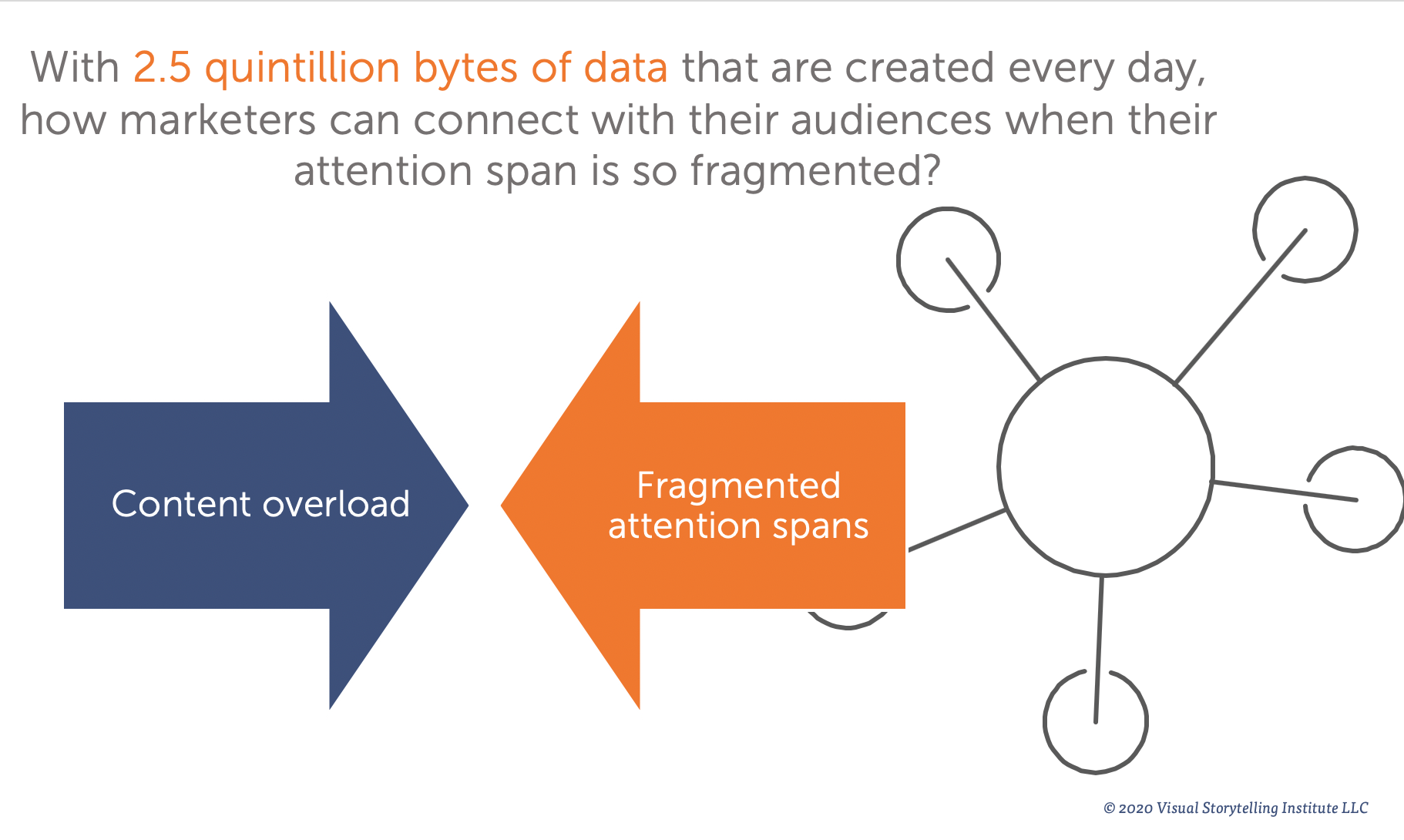
So if you’re wondering as a business leader why should I care about visual storytelling? Then the above visual should be an eye-opener. The stakes are high. Communication barriers cost the average organization $62.4 million per year in lost productivity (Holmes Report). And the Harvard Business Review states that information overload costs the U.S. economy $900 billion a year!
Today’s communication noise is marked by 2 opposing forces:
1) Content explosion: a dramatic and continual increase in content production,
> “4.6 billion pieces of content are produced every day” – LinkedIn
and content consumption is further enabled by greater broadband and mobile access.
> 70% of the world mobile data traffic will be video by 2020” – Cisco
VERSUS
2) Fragmented user attention span: Selective attention span that on one hand allows one to be banner blind but at the same time binge for four hours on the Love is Blind TV series on Netflix.
BTW let’s all forget about that misleading viral stat that claimed a human attention span is one second shorter than a goldfish.
And don’t just take my word for it, a 2019 eMarketer report indicated that the second-highest challenge CMOs are struggling with after “Driving growth” is “Delivering a powerful brand that breaks through the clutter.”
To add fuel to the fire, not only do marketers find it hard to connect with audiences because of the growing communication noise, but these days we also realize that often the audience is not at all there. Either due to digital fatigue or cutting down on digital consumption: 1 in 5 have been completely disconnected, but 7 in 10 are on a digital diet (GlobalWebIndex). Due to the growing disinformation, audiences are replaced by bots that produce social content as if they’re real people.
The rules have changed and audiences today demand meaningful stories by real people – stories about their problems not about the products’ speed and feeds in order to meet marketers’ growth targets.
We recognize 2 core drivers that support effective visual storytelling:
1. Our human brain processes visuals much faster than text
> “Visuals are processed 60,000 times faster than text by the human brain and 90% of information transmitted to the brain is visual” -3M
2. The human brain prefers information packaged as stories
> “92% of consumers want brands to make their ads feel like stories. -OneSpot
So what is the definition of visual storytelling
in the context of marketing?
“Visual Storytelling is a marketing strategy that leverages compelling narratives, placing your customer at the heart of the story, staged with an emotional visual media experience and effectively distributed across your buyer’s journey – to empower people’s lives and drive business results.”
– Shlomi Ron
Founder & CEO, Visual Storytelling Institute
———
Need help with your visual storytelling project?
Take advantage of my On-Demand 1:1 Advisory program.
Book your session today!
That means that in order to cut through the clutter and resonate with your audience, as a visual storyteller you need to put your customer as the hero of your story, addressing first her needs – not yours. Why? As Rolf Jensen of the Copenhagen Institute of Future Studies aptly states: “The task of marketers today is no longer to sell the drill, nor hole in the wall, but to sell the experience of making that hole or the lifestyle the hole enables us to.” He added that we’re entering the emotion-oriented “dream society” where customers take for granted the functionality of products and make purchase decisions based upon to what degree they believe a product will give them positive experiences (source: Storytelling Advertising – a Visual Marketing Analysis by Sarah Elise Väre).
Experience is key.
And companies that sell experiences, rather than product/service functions are poised to be rewarded with audience attention. A great example is Apple. Some of us own old iPhone devices that work perfectly fine, but regardless we gotta have the new iPhone model, even with its marginal upgrade benefits. It’s that unique experience that the Apple story enables.
If you check Wikipedia under Storytelling, there is a whole section devoted to storytelling in business and marketing. Marketers use storytelling techniques because humans have an ingrained need to be entertained rather than being interrupted by irrelevant sales pitches.
With all the hype surrounding virtual reality (VR) these days, visual storytellers need to mentally put on VR goggles and see the world through their customer’s eyes. It’s about introducing authentic narrative elements to illustrate a meaningful challenge your customer (aka your story’s hero) is facing and how you – as the brand marketer (aka your story’s mentor) – can help them solve it with outcomes impacting both the business and personal levels.
Also, it’s important to keep in mind, that even though the word ‘visual’ comes first in Visual Storytelling, in practice it should always come second. That’s why I launched the Visual Storytelling Institute (VSI) where we use our signature “My Visual Story” framework in our client workshops and production projects:
Phase 1: STORY MAKING
Objective: Identify your Brand Narrative.
Extract your brand’s backstory and purpose, top buyer personas, and goals (Setting), identify your buyers’ core challenges and emotional and meaning maps (Conflict), and finally craft brand identity, brand voice, solution benefits, target emotions, and key differentiators (Resolution).
Outcome: One-liner Brand Narrative to set your brand purpose answering WHY your brand exists beyond making money.
Phase 2: STORY VISUALIZING
Objective: Develop content plans and visual stories.
Find and dramatize real-life visual stories that function as proof points to your resulting Brand Narrative and support your business goals. The step-by-step process covers aligning content purpose to story types, buyer segments, buying stage and target platform (Plan), script and producing customer-centric visual stories that meld your brand’s unique tone and target emotions (Create), and finally editing your visual stories to maximize response (EDIT).
Outcome: Content plan with supporting visual stories such as a video explainer, image, infographic, presentation all the way up to Augmented Reality and Virtual Reality experiences.
Phase 3: STORY TELLING
Objective: Engagement plan.
Set marketing objectives and SMART goals (Strategize), develop an engagement plan per your customer’s distinct information needs at each stage of the buyer’s journey, document visual stories and owners in a Content Editorial Calendar (Engage), and finally, tracking, rinsing and optimizing performance (Optimize) – to drive optimal product adoption.
Outcome: Your engagement plan across channels.
And in case you wondered if you are a STORYTELLER or STORY MAKER, then the answer is quite simpler than you’d think.
The magic happens only when your business story carries a good dose of vulnerability or imperfection that allows your audience to see the human aspects of your narrative and this way develop trust and empathy towards your message (i.e., mirroring themselves in your story).
Why? Psychology researcher Uri Hasson has coined the phenomenon of Neural Coupling which allows us an audience to vicariously experience a storied event in our mind while being exposed to it. That means, when we read stories packed with details of distinct feelings, colors, or odors, the same region in our brain is activated as if we would smell that particular odor or experience that feeling in real life.
How does the discipline look like?
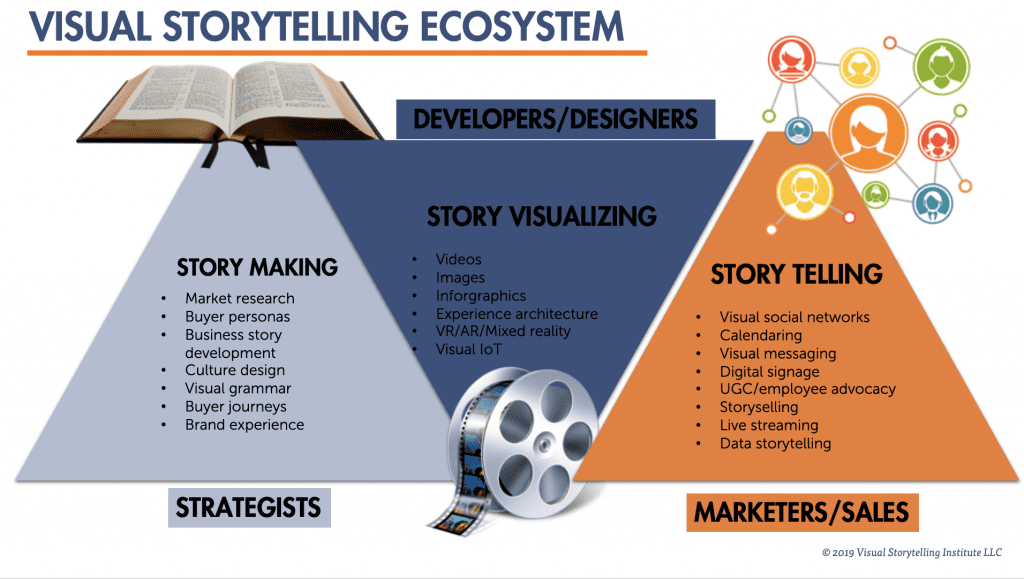 *Note: Behind each of the items listed above, there are complete sub-industries that offer either on-demand visual content management platforms or agency-side consulting.
*Note: Behind each of the items listed above, there are complete sub-industries that offer either on-demand visual content management platforms or agency-side consulting.
In closing, my core message for you – the marketer – entering this new landscape is quite simple.
When both your super creative 11-year-old nephew and a digital manager at a Fortune 100 brand have access to the same communication tools and organic influence on the attention battlefield, then the battle will be decided by strategy and skill. YOUR STORY!
And not just any stories, it’s those stories that will authentically mirror your audience’s problem, emotionally ignite their sense of identity and in the process will transform your story into THEIR STORY!
Uncover the key ingredients for
developing an effective visual story
Need help with your visual storytelling strategy? Schedule a FREE chat!
Shlomi Ron
Shlomi Ron is the founder and CEO of the Visual Storytelling Institute, a Miami-based think tank with a mission to bring the gospel of visual storytelling from the world of art to more human-centric and purpose-driven marketing. A digital marketing veteran with over 20 years of experience working both on the agency and brand sides for Fortune 100/500 brands such as Nokia, IBM, and American Express. He started VSI to combine his marketing expertise with his passion for visual stories stemming from his interests in classic Italian cinema and managing the estate of video art pioneer, Buky Schwartz. At VSI, he helps brands rise above the communication noise through visual storytelling consulting, training, and thought leadership. Select clients include Estée Lauder, Microsoft, and Cable & Wireless – to name a few. He currently teaches Brand Storytelling at the University of Miami’s Business School. Thought leader and speaker at key marketing conferences. He is also the host of the Visual Storytelling Today podcast, which ranks in the top 10 best business storytelling podcasts on the Web. His book: Total Acuity: Tales with Marketing Morals to Help You Create Richer Visual Brand Stories. Outside work, he is a nascent bread baker, The Moth fan, and longtime fedora wearer likely to jive with his classic Italian cinema interest.
All stories by: Shlomi RonYou might also like
48 comments
Leave a Reply Cancel Reply
This site uses Akismet to reduce spam. Learn how your comment data is processed.


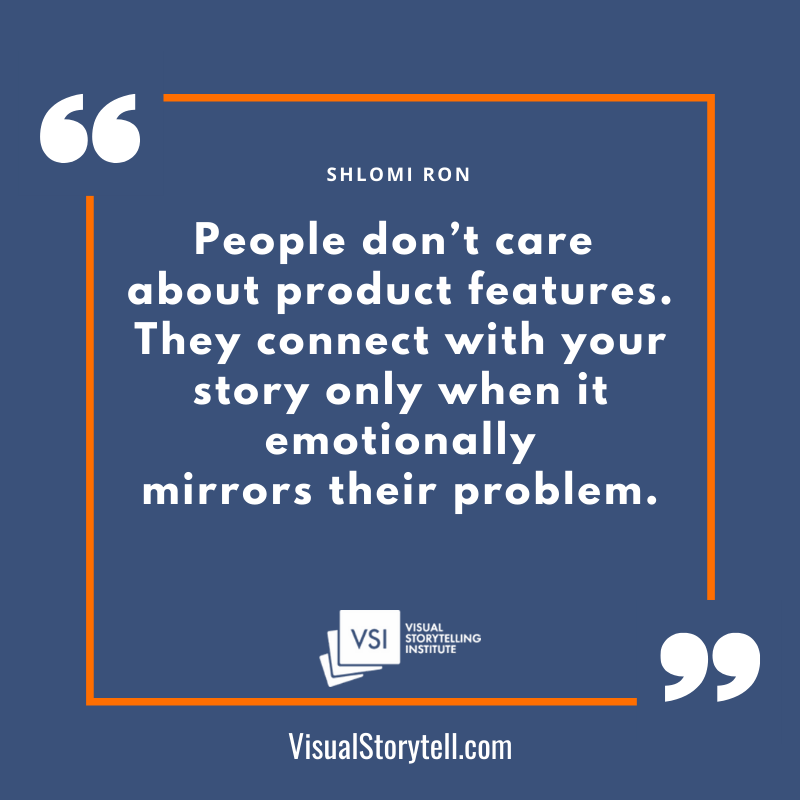
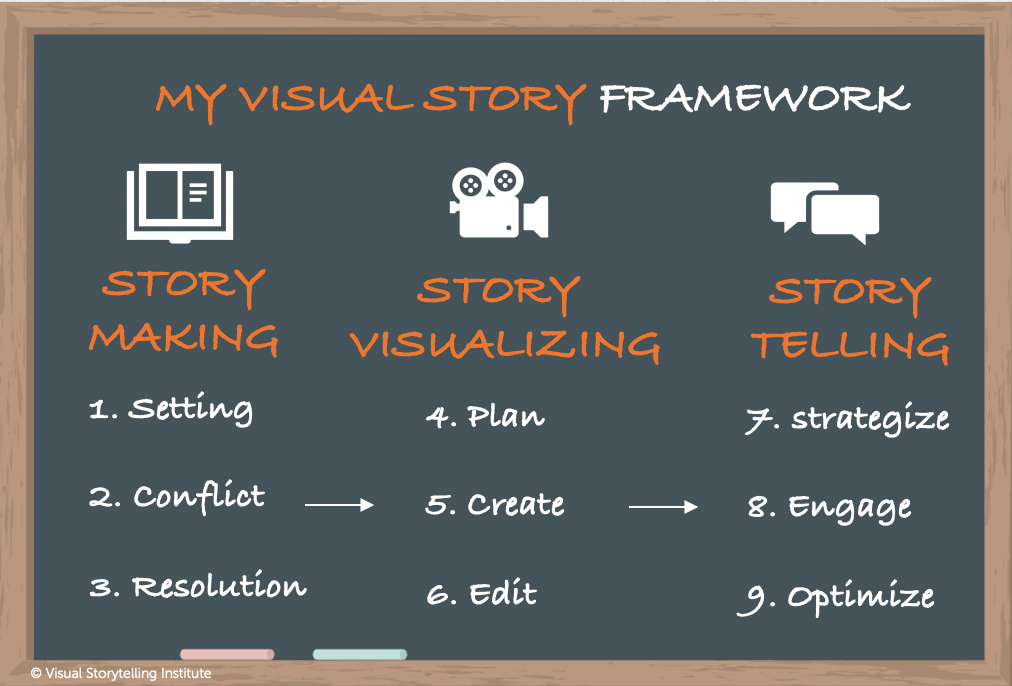



Jan Sitvast
Dear Shlomi,,
I am a researcher and lectured at an university of Applied Sciences (Hogeschool Utrecht) in the Netherlands. I retired sept. 1st 2020.
My research was in the field of visual narrative and how to apply narrative methodology in mental health care. I focused on visual narrative, in which I took my PhD in 2011. Just recently I published a book with outcomes of my research in the period since 2011. May I draw your attention to this publication? The title is: How Nurses Can Facilitate Meaning-making and Dialogue: Reflections on Narrative and Photo Stories, was published on 2021-01-06. It can be found on the website of the publishing company:
https://www.cambridgescholars.com/product/978-1-5275-5980-6
Kind regards
Jan Sitvast